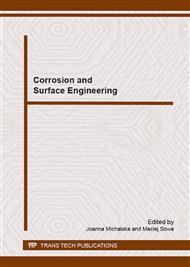p.79
p.83
p.87
p.91
p.95
p.99
p.103
p.107
p.111
Electrochemical Corrosion Behaviour of Stainless Steels AISI 304 and 316L in Caribbean Sea Water
Abstract:
AISI 304 and 316L flat samples were exposed during 3 months in Carribean sea water.At the end of the experiment Ecorr of AISI 316L reached one-half the negative potential value than that of AISI 304. The tendencies of Ecorr were correlated with the pitting corrosion development. They could be considered as a consequence of the opposition between the nucleation of new pits and repassivation of active sites. The analysis of Ecorr fluctuations was carried out with the potential spectral density (PSD) vs. frequency in logarithmic scale. The decrease of the PSD slopes, exponent b values, indicated a release of spontaneous energy with the advance of pits formation on the stainless steel surface. The data showed that in the range of low frequencies the process that occurs on both stainless steels surfaces could be considered as fractional Brownian motion, an anti-persistent non-stationary process, while in the range of higher frequencies as fractional Gaussian noise, an persistent stationary.
Info:
Periodical:
Pages:
95-98
Citation:
Online since:
January 2015
Authors:
Keywords:
Price:
Сopyright:
© 2015 Trans Tech Publications Ltd. All Rights Reserved
Share:
Citation:


